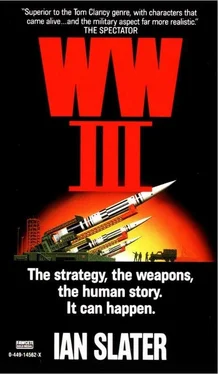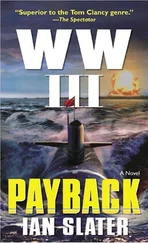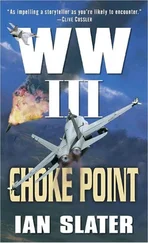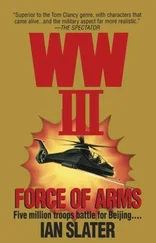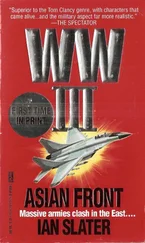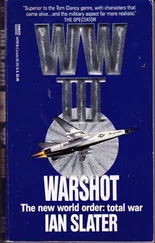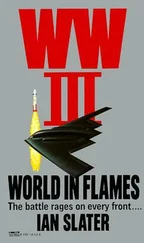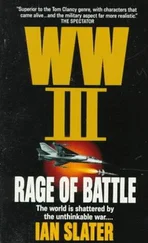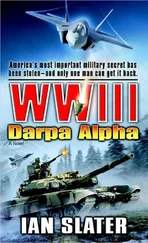Ian Slater - WW III
Здесь есть возможность читать онлайн «Ian Slater - WW III» весь текст электронной книги совершенно бесплатно (целиком полную версию без сокращений). В некоторых случаях можно слушать аудио, скачать через торрент в формате fb2 и присутствует краткое содержание. Год выпуска: 1990, ISBN: 1990, Издательство: Fawcett, Жанр: Триллер, на английском языке. Описание произведения, (предисловие) а так же отзывы посетителей доступны на портале библиотеки ЛибКат.
- Название:WW III
- Автор:
- Издательство:Fawcett
- Жанр:
- Год:1990
- ISBN:978-0449145623
- Рейтинг книги:3 / 5. Голосов: 1
-
Избранное:Добавить в избранное
- Отзывы:
-
Ваша оценка:
- 60
- 1
- 2
- 3
- 4
- 5
WW III: краткое содержание, описание и аннотация
Предлагаем к чтению аннотацию, описание, краткое содержание или предисловие (зависит от того, что написал сам автор книги «WW III»). Если вы не нашли необходимую информацию о книге — напишите в комментариях, мы постараемся отыскать её.
In Europe — Twenty Soviet Warsaw Pact infantry divisions and four thousand tanks begin to move. They are preceded by hundreds of strike aircraft. All are pointed toward the Fulda Gap. And World War III begins…
WW III — читать онлайн бесплатно полную книгу (весь текст) целиком
Ниже представлен текст книги, разбитый по страницам. Система сохранения места последней прочитанной страницы, позволяет с удобством читать онлайн бесплатно книгу «WW III», без необходимости каждый раз заново искать на чём Вы остановились. Поставьте закладку, и сможете в любой момент перейти на страницу, на которой закончили чтение.
Интервал:
Закладка:
There was a bright orange flame forward of the starboard beam about three hundred yards into the fog, an enemy missile hit, and a second later the crash of a destroyed Nanuchka came rolling over the ship. At the same time the TAO reported, “Bogey missiles destroyed.” There was a cheer in the combat information center, cut short by the TAO’s command to the radar operators to compensate for clutter caused by the Blaine’s own chaff and the increasing chop caused by the wash of the remaining sixteen NKA boats. A sharp pulse of light on the radar and seconds later the sound of an explosion told them another Nanuchka had been hit, but Brentwood was worrying about the changing positions of the two remaining Nanuchkas. To maintain flank speed would mean entering the swarm sooner, but to slacken off would give him less maneuverability — the fact that the two Nanuchkas were slowing down didn’t abate his fears as they had separated to form the two tips of a bull’s-horn formation. Meanwhile the armored shell of the Blaine’s combat information center being below the bridge, Brentwood and the others were only dimly aware of the cacophony of firing outside as the Shershen attack boats coming at him broadside opened up with thirty-millimeter fire and began launching their torpedoes from staggered overlap tubes, the bull’s-horn-like formation of fast boats now becoming a rough semicircle of a half-mile radius, launching twenty torpedoes at the Blaine.
“Fish incoming!” called one of the radar operators. “Bearing—” The operator stopped.
Brentwood swung around, saw the problem — there were so many, a single bearing wouldn’t help. “Hard left ninety!” he ordered, reducing the sector of the torpedo attack to a quarter instead of a half circle and hoping to outrun the incoming torpedoes now coming at him from abaft the starboard beam but also putting the Blaine broadside to the extreme left half of the semicircle; the lead boat, a Nanuchka, closest to him, he now engaged with another two Harpoon missiles. The blip that was the Nanuchka amid the dancing fuzz of chaff and other clutter suddenly grew very bright on the screen, then disappeared.
“Hard right, ninety degrees!” he shouted, anticipating a cheer or two from the CIC crew, but now everyone was silent, only the hum of the electronics and that tattoolike din outside faintly audible above the radio crackle of the two helicopters, one pilot yelling at the other, “Two o’clock, two o’clock!” and they actually heard the sound of a missile passing one of the helos. In quick succession another three torpedo boats blossomed on the screens and disappeared, taken out by the helos, but now they could hear the scream of the electronics warfare officer aboard one of the choppers as he was hit by machine-gun fire. Seconds later they heard the bang of the helicopter hitting the water, followed by the rattle of machine-gun fire— the attack boats raking the Blaine’s starboard side.
“Fish incoming starboard quarter!”
Brentwood knew he could do nothing, the torpedo-tracking radar and digital sonar now malfunctioning, and knew that either hard right or hard left would expose his stern to the torpedoes racing toward him at over fifty miles an hour. Two torpedoes went past, whitish-gray streaks in the fog, the startled starboard lookout informing the bridge a second later.
A machine-gun burst hit the Blaine’s stack, puncturing it but doing no more damage as the ship’s Gatling gun swung sharply, continuing to fire, causing another missile to explode within a few hundred yards of the ship, but now the Blaine’s Phalanx radar was in danger of “fuzzing up” from overload. The sonar operator, ignoring all else, carefully monitored the sea bottom, alert for the telltale ping of mines, while his colleague on the 225-mile-range air-search radar informed the tactical action officer that the radar’s dish, between the bridge and the satellite communications dome, was out. Brentwood knew that of all the battle group ships on forward screen for the carrier Salt Lake City, the Blaine, like her sister ship the USS Des Moines, forty miles to the east and closing to assist the guided missile frigate, had never been designed to go it alone in such outnumbered circumstances. The frigate’s weapon system had been designed primarily for medium-range escort duty, for what the Pentagon had designated a “low-threat” environment. And the Sea of Japan had been just that — until the NKA had crossed the DMZ.
“Sir!” the surface radar operator began, but then checked his excitement. “Enemy disengaging.”
No one in the CIC or anywhere else on the ship eased off, knowing it could be a sucker ploy. But the operator proved right; after losing six patrol boats and only damaging the American warship, though they had downed one of its helicopters, the NKA naval force, it seemed, had had enough. Still, Brentwood kept everyone at their stations, despite their fatigue and the stench of perspiration thick in the air. Even as the enemy was retreating, he ordered another four Harpoons “onto the rails,” and in the bowels of the ship the loader pressed the button for the automatic feed, quipping, half in relief, half in celebration, “ Four pack to go.” Brentwood made an immediate note to enter into the ship’s log, together with the tape that, like a civilian aircraft’s black box, was set to start recording the moment a U.S. Navy vessel went on “Action Station Alert,” how astonishingly ineffective the Nanuchkas’ missiles had been. Now it seemed all the peacetime speculation was over. The suspicion among the experts that quantity rather than quality was the central theme of the NKA’s, that is, the Russians’, strategy seemed confirmed.
“Inbound missile, inbound missile!” All the lookout saw in the fog was a blue sphere of light the size of a basketball, the sixteen-hundred-pound Exocet skimmer coming in amid the radar clutter, hitting the Blaine amidships on the starboard side, ripping open the three-quarter-inch armor plating like a fist through glass.
Six miles south of Uijongbu, Lieutenant Clemens saw the line of sixty-four green PT-76s halt. Through his binoculars he could see the enemy tank commander emerge, wearing the Russian-style leather helmet, looking a little like a World War II pilot, big bumps over the earpieces.
“C’mon,” said Clemens, “c’mon. God, make him…” Then Clemens saw the NKA commander thump the cupola, and the tank, its gravelly roar giving off a thick, bluish exhaust, moved forward again, leading the column.
When the lead PT-76 was well within the one-thousand-meter range, Clemens gave the order to fire. The M-1’s gunner pushed the ranging button, activating the split-second computerization, then squeezed the trigger. There was the thud of the recoil, but the M-1 hardly moved because of the superb suspension of the seven-road wheels sprung on each side on torsion bars. The HESH, or high-explosive squash head, round did its job, hitting the PT-76’s sloped glacis plate with such force that it blew off scabs of red-hot steel inside the PT-76, creating a lethal shrapnel. Within seconds the PT-76 slewed to a stop, three figures, all on fire, tumbling out of it, the driver trapped in his hull seat beyond the turret. Soon the whole tank was engulfed by fire, the molten scabs of white-hot shrapnel igniting the tank’s oil reservoir, creating a thick, billowing cloud of black smoke. To Clemens’ dismay the smoke was widening and flowing back over the column in as effective a smoke screen as he’d ever seen laid, many of the PT-76s now adding to it by popping off clusters of smoke grenades left and right of the road. Within minutes the entire tank column was enveloped, hidden from the view of the two American tank platoons, in all six tanks, that were situated in strategic firing positions under camouflage nets either side of the road behind a rise that was now only nine hundred meters in front of the NKA armor. But Clemens and two other M-1s fired at the second and third PT-76s, the HESH rounds stopping them, too, dead in their tracks, littering and blocking the road with their burning wreckage. But though the Americans had stopped them, the PT-76s immediately behind the gutted hulls kept returning fire.
Читать дальшеИнтервал:
Закладка:
Похожие книги на «WW III»
Представляем Вашему вниманию похожие книги на «WW III» списком для выбора. Мы отобрали схожую по названию и смыслу литературу в надежде предоставить читателям больше вариантов отыскать новые, интересные, ещё непрочитанные произведения.
Обсуждение, отзывы о книге «WW III» и просто собственные мнения читателей. Оставьте ваши комментарии, напишите, что Вы думаете о произведении, его смысле или главных героях. Укажите что конкретно понравилось, а что нет, и почему Вы так считаете.
